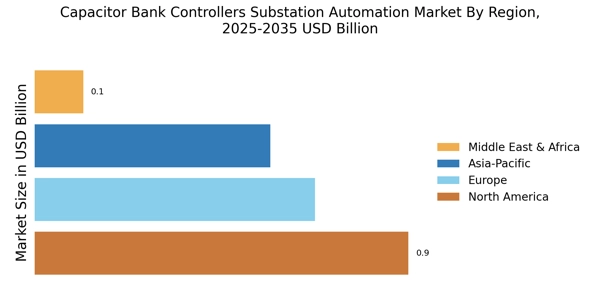Growing Focus on Grid Modernization
The ongoing focus on grid modernization is a significant driver for the Capacitor Bank Controllers Substation Automation Market. Utilities are investing in upgrading their infrastructure to accommodate the increasing complexity of energy distribution. Capacitor bank controllers are integral to this modernization effort, as they enhance grid reliability and efficiency. The market is expected to benefit from substantial investments in smart grid initiatives, with estimates suggesting that global spending on grid modernization could exceed $100 billion by 2027. This trend indicates a robust demand for advanced capacitor bank controllers that can support the evolving needs of modern electrical grids.
Advancements in Automation Technologies
Technological advancements in automation are significantly influencing the Capacitor Bank Controllers Substation Automation Market. The integration of advanced control systems, such as digital relays and smart sensors, enhances the functionality of capacitor bank controllers. These innovations facilitate real-time monitoring and control, leading to improved system performance and reduced operational costs. The market is witnessing a shift towards automated solutions that can adapt to varying load conditions, thereby optimizing capacitor usage. As utilities increasingly adopt these technologies, the demand for sophisticated capacitor bank controllers is expected to rise, potentially leading to a market expansion of around 5% annually in the coming years.
Rising Demand for Efficient Power Management
The increasing demand for efficient power management solutions is a primary driver for the Capacitor Bank Controllers Substation Automation Market. As energy consumption continues to rise, utilities are compelled to enhance their operational efficiency. Capacitor bank controllers play a crucial role in managing reactive power, thereby improving voltage stability and reducing losses. According to recent data, the market for capacitor bank controllers is projected to grow at a compound annual growth rate of approximately 6% over the next five years. This growth is indicative of the industry's shift towards automation and smart grid technologies, which are essential for optimizing power distribution and ensuring reliability in energy supply.
Increased Adoption of Renewable Energy Sources
The increased adoption of renewable energy sources is reshaping the Capacitor Bank Controllers Substation Automation Market. As more utilities integrate solar, wind, and other renewable sources into their energy mix, the need for effective reactive power management becomes critical. Capacitor bank controllers help stabilize voltage levels and improve power quality, which is essential for accommodating the intermittent nature of renewable energy. The market is likely to see a surge in demand for these controllers, as utilities strive to meet renewable energy targets and enhance grid resilience. Projections indicate that the renewable energy sector could drive a 7% increase in the capacitor bank controller market over the next few years.
Regulatory Pressures and Compliance Requirements
Regulatory pressures and compliance requirements are increasingly influencing the Capacitor Bank Controllers Substation Automation Market. Governments and regulatory bodies are implementing stringent standards aimed at improving energy efficiency and reducing carbon emissions. These regulations often mandate the use of advanced technologies, including capacitor bank controllers, to ensure compliance. As utilities strive to meet these requirements, the demand for efficient and reliable capacitor bank controllers is expected to rise. The market could experience a growth rate of approximately 4% as utilities invest in technologies that not only comply with regulations but also enhance overall system performance.

















Leave a Comment